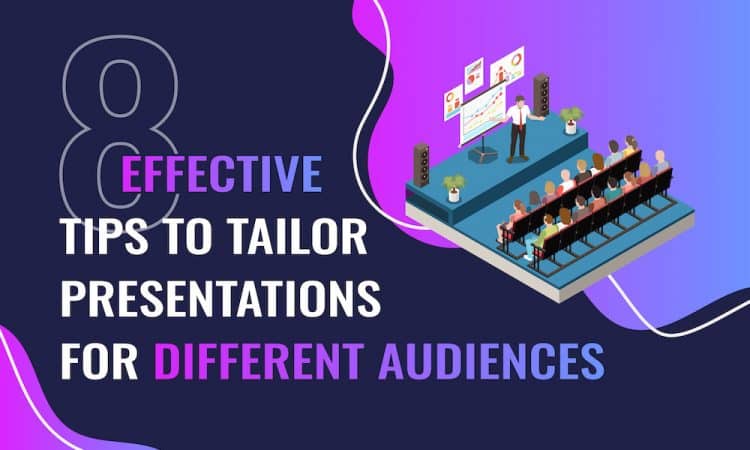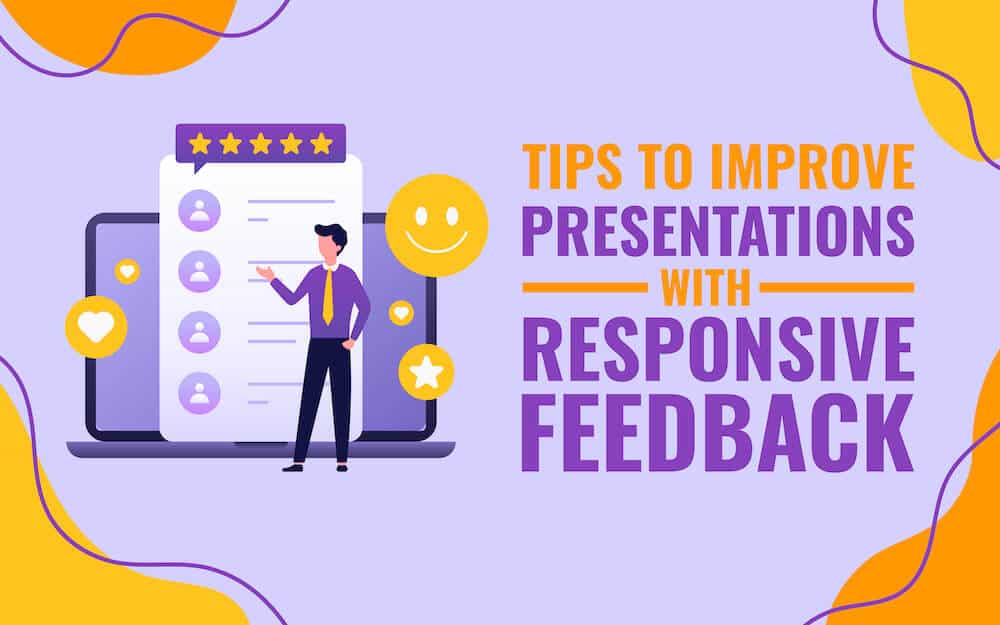
Imagine sitting for a finance presentation as a young college graduate with little experience in the field. As the presenter begins his slideshow, you realize that the terms being used are words that you have never heard before, and his examples are from books and articles that you have no idea of.
You look into the audience and find them actively participating because their level of experience is higher than yours. However, you do come across a couple of blank canvases, and by the end of the presentation, you are all left disheartened and disappointed.
Well, had the presenter begun from scratch or delivered a couple of handouts to you before commencing the session, it would have been much easier to fathom the information being presented and get on the same page as the rest of the audience.
However, when this wasn’t done, you were left disappointed. Thus, it is extremely crucial to tailor the presentation according to your audience and adapt to their style of learning, understanding, etc.
As you embark on your journey to become a presenter, remember that the process of tailoring is not a one-size-fits-all endeavor. Each audience you encounter is like a unique canvas, and your ability to adapt and customize your content, language, and tone is the brushstroke that brings your message to life.
In this article, we will take you through some tips and techniques that will help you alter your presentation in accordance with the audience and leave an indelible mark on them.
1. Conduct an Audience Analysis
Effective audience analysis is a stepping stone to tailoring presentations. It involves gathering information about your audience’s demographics, preferences, and needs and curating your content according to them.
For instance, consider you’re making a presentation for a group of middle-aged employees working in the health sector. You can include examples relevant to their generation and use slightly formal language. However, if the same content has to be delivered to newly graduated medical students, you can incorporate humor and satire and talk in an informal tone.
2. Focus on Providing More Value with Custom Content
Customizing your content involves adjusting the essence of your presentation to meet the unique needs and expectations of the audience.
Let us understand further with the help of an example. Imagine that you need to deliver a financial report to a mixed group of audience. This includes high-level executives as well as amateur analysts. Instead of curating a report that is dedicated to one group, you must present specific reports for each one, such as a high-level summary for executives and more detailed financial data and analysis for analysts. This way, you cater to the specific interests and expertise levels of each group.
Thus, it is extremely crucial to be adaptable to increase the likelihood of achieving your presentation’s goals.
You can also consider using data analytics to track audience engagement during your presentation. Tools like webinar analytics or social media insights can provide real-time feedback on which parts of your presentation are resonating with your audience. Use this data to make on-the-fly adjustments and emphasize content that is particularly relevant or interesting to your audience.
3. Adapt the Language, Tone, and Style of Communication
Delivering presentations to multilingual audiences can seem quite a challenging task. Thus, before the big day, ensure that you know well about your audience’s linguistic preferences and can speak and understand the languages they are comfortable with.
However, if you cannot understand their dialect, it is crucial to have a translator alongside or use AI-backed chatbots that can translate their questions and your content in real-time. It will allow you to bridge any barriers that may arise during the presentation.
Another critical aspect is fine-tuning the tone and content as per the audience’s communication preferences. You can review industry-specific forums or social media groups to understand how professionals in a specific field communicate. It’s also helpful to have a clear understanding of the formality expected in your industry or niche.
Consider the contrast between an investor pitch presentation and a product awareness presentation. The former may require complex terminology and a formal tone to address professionals, while the latter demands simplicity and a friendly tone to connect with a diverse public.
4. Be Mindful of Cultural Sensitivities
Acknowledging and respecting cultural differences is crucial when presenting to diverse audiences. Cultural sensitivities can impact how your message is received and interpreted and can determine the success of your presentation.
Consider you are presenting to an international audience overseas. In such a situation, it is crucial to research and be aware of cultural norms and taboos related to gestures, humor, etc. An innocuous gesture in one culture may carry a negative connotation in another, leading to misunderstandings.
Let us delve deeper into the example of Coca-Cola and how the brand is a prime example of considering cultural sensitivities. When launching in foreign markets, Coca-Cola conducts thorough cultural research to ensure that its campaigns and brand messaging are respectful and culturally appropriate. This approach helps avoid unintended offense and fosters a positive brand image.
Have a look at Coke’s Australia commercial for the “Share a Coke” campaign
Look at the same campaign’s advertisement for India
Even though the crux of the video remains the same, it has been altered according to the culture of these countries, making it easier to resonate with.
5. Convey Why They Need Your Presentation
Demonstrating the relevance of your presentation to your audience’s needs is a persuasive technique. Start your presentation by explicitly stating why it’s important for your audience.
For instance, if you’re delivering a training session on time management to employees, begin by explaining how improved time management can lead to reduced stress and increased productivity in their daily work.
Use relatable examples and scenarios that resonate with their experiences and share anecdotes or case studies that showcase how the information or solutions you’re presenting have directly benefited others in similar situations.
For instance, whenever Apple launches a new product, the company begins its presentations with a detailed story on why the world requires its newly launched gadget. It strategically narrates a story on how its new devices and features will make users’ lives more convenient and enjoyable. By immediately emphasizing the relevance of their products to consumers’ daily experiences, Apple creates a strong connection between their audience and their offerings.
Watch how Steve Jobs brought up a similar narrative during the launch of the first iPhone in 2007
6. Harness the Power of Visuals and Graphics
Visuals add meaning to your slides and make them stand apart. Using the right visuals and graphics is extremely vital to meet the expectations of your audience. For instance, you can use delightful illustrations and colorful charts for a group of elementary students. However, for executive education, you must opt for sophisticated charts and graphs that convey complex information clearly.
Keep in mind that visuals should complement and reinforce your message. Avoid using unnecessary or distracting visuals that don’t directly contribute to your presentation’s goals.
We understand that crafting such detailed graphs and visuals from scratch can be quite a burdensome task and consume much of your energy. Thus, we suggest using expert-designed presentation templates that can be customized completely according to your needs.
7. Tailor the Length According to Their Schedules
The duration of your presentation should match your audience’s attention span and schedule. Different audiences have varying levels of tolerance for lengthy presentations, so be mindful of their needs.
For example, if you’re presenting to busy executives, aim for a concise, focused presentation that respects their time constraints. Ensure that your main points are clear and accessible within a short timeframe. Conversely, if you’re presenting to a group of subject matter experts who require in-depth information, allocate sufficient time for thorough explanations and discussions.
8. Use Relatable References
Creating a sense of relatability fosters deep emotional connection with the audience and increases their retention. It also establishes your credibility as a presenter and enables the viewers to remember you for a long time.
For instance, while presenting marketing strategies to a tech-savvy audience, you might refer to well-known tech companies like Apple or Google to illustrate your points. However, in the context of educational presentations for professors, referencing well-known educators, researchers, or institutions can establish credibility and resonate with the academic background of your audience.
Conclusion
In the realm of presentations, the ability to tailor your message to different audiences is the linchpin of effective communication. It’s the difference between a presentation that resonates and one that falls flat.
Ultimately, tailoring presentations is more than just a skill; it’s a strategic approach to communication that empowers you to bridge gaps and foster connections. We hope this article helps you curate a presentation that suits the needs of your audience!



